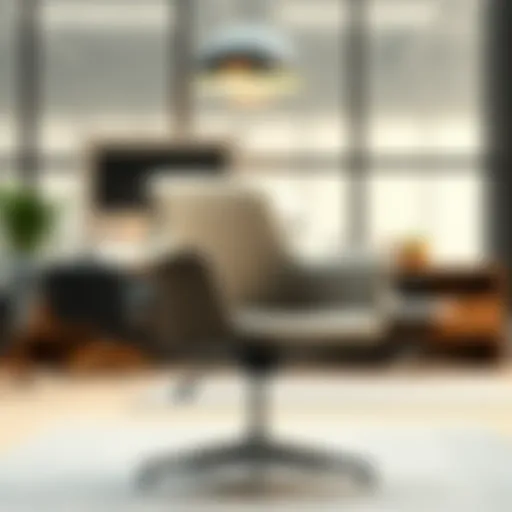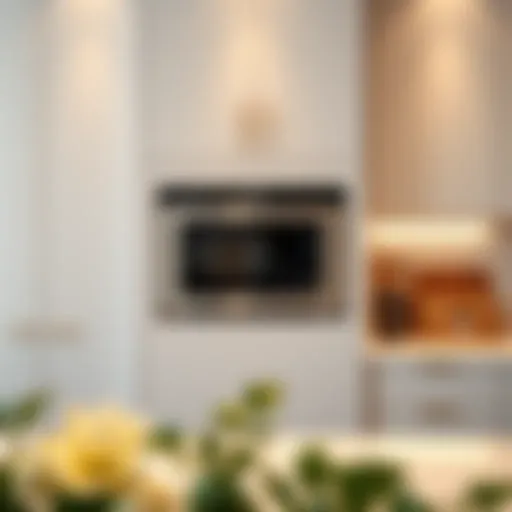Exploring Roman Blinds: A Complete Guide to Window Treatment
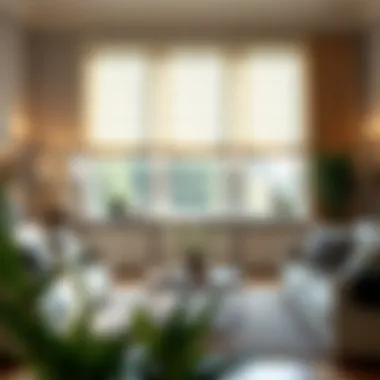
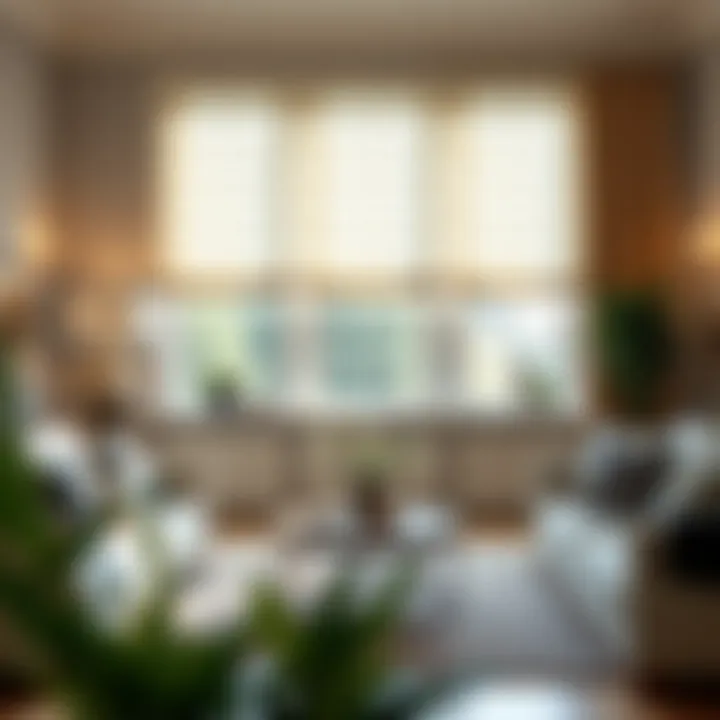
Intro
Roman blinds have become notably popular in the realm of window treatments, not merely for their aesthetic appeal but for their practicality as well. With a myriad of designs, materials, and functionalities available, homeowners and designers are increasingly gravitating towards these versatile window coverings. This guide aims to provide a deep dive into the world of roman blinds, detailing everything from design trends and practical considerations to tips for installation and maintenance.
Through the exploration of current design trends, readers will understand how roman blinds can seamlessly integrate into various styles of home interiors. Additionally, the practical side will encompass aspects such as light control and ease of use, which are paramount for a comfortable living environment.
Furthermore, a thoughtful examination of quality and material choices will prepare potential buyers to make informed decisions that align with both their needs and their taste. Overall, this resource serves as a comprehensive overview intended to enlighten and assist anyone considering roman blinds for their living spaces.
Design Trends
Roman blinds can fit snugly into a multitude of design trends, making them a suitable choice for both contemporary and traditional aesthetics. The current landscape features a blend of minimalism and maximalism, alongside a nod to the nostalgic charm of vintage styles.
Current Trends in Furniture Styles
A minimalist design, often characterized by clean lines and neutral tones, calls for window treatments that enhance the serene simplicity of the space. In such cases, choosing roman blinds in soft colors or earthy hues can maintain this aesthetic. Conversely, a maximalist interior—full of bold colors and patterns—benefits from roman blinds that act as a statement piece; think bright fabrics or intricate prints.
It’s essential to consider how window treatments complement existing design elements.
How to Incorporate Trends into Your Space
Integrating these trends involves a few thoughtful steps:
- Assess Your Room’s Style: Look around your space. What vibe does it give off? It’s easier to harmonize your roman blinds with the existing decor than to force a mismatched look.
- Choose Colors Wisely: Whether you’re going for subtlety or striking contrasts, consider colors that reflect the mood you want to create.
- Play with Textures: The texture of the fabric can change the entire feel of a room. A soft linen might lend a relaxed vibe, while a silk fabric could enhance sophistication.
Buying Guides
When it comes to selecting the right roman blinds, there are several practical aspects to consider. A judicious choice can ensure both immediate satisfaction and long-term utility.
Choosing the Right Material for Different Rooms
Think about where the blinds will be used. In kitchens or bathrooms, moisture-resistant materials are a smart choice, while living rooms or bedrooms can showcase a wider variety of fabrics. For instance:
- Cotton: Ideal for living spaces due to its lightness and durability.
- Polyester: Offers excellent resistance to fading and is easier to clean, making it great for high-traffic areas.
- Linen: Provides a luxurious feel but may require more maintenance due to its inclination to wrinkle.
Tips for Assessing Quality and Value
Quality plays a crucial role in the longevity and functionality of the blinds. Look for these indicators:
- Stitch Quality: Inspect the fabric’s edges. Clean, tight stitches indicate better craftsmanship.
- Hardware Durability: Ensure the mechanisms that raise and lower the blinds are robust; plastic components may wear out quicker than metal.
- Sun Protection Features: Consider fabrics that offer UV protection, particularly if the sun regularly beats down on your windows.
Intro to Roman Blinds
Roman blinds have carved a niche in the realm of window treatments, merging style and substance in a way that appeals to both aesthetic sensibilities and practical needs. Their sleek, tailored appearance adds a touch of elegance to any room, making them a popular choice among homeowners, designers, and DIY enthusiasts alike. This section aims to pave the way for a deeper understanding of what sets Roman blinds apart and why they deserve consideration in interior design.
Understanding Roman blinds is not merely about recognizing their physical attributes; it also involves grasping their vast potential for enhancing living spaces. They can transform an otherwise ordinary window into a focal point, turning sunlight into a warm highlight of home design. In this guide, the reader will discover aspects like fabric choices, installation techniques, and the numerous styles available, which will assist in making informed decisions.
Furthermore, contemplating the role of Roman blinds cannot be underestimated. These window treatments aren’t just for decoration; they influence light control, privacy, and even energy efficiency. Their layering of fabric can provide a barrier against unwanted light, allowing for serene spaces in homes. Additionally, Roman blinds offer a versatile solution suitable for various room themes, from rustic to modern.
Defining Roman Blinds
At their core, Roman blinds are a type of window treatment that consists of fabric panels that pleat when raised and lay flat when lowered. This functionality gives them a distinctive look that can make a space feel organized and polished. They differ from other types of blinds due to their smooth fold, which offers a clean line and a sophisticated finish. The operational mechanism can be either manual or motorized, allowing for further customization according to user preference.
There are several variations worth discussing, including flat Roman blinds, which maintain a sleek appearance, and hobbled styles, which create a more layered look. Depending on personal taste and the intended atmosphere of a room, either style can meet specific needs.
Historical Context
The origins of Roman blinds trace back to ancient Rome, where textiles were used to cool and shade their inhabitants from the hot sun. The Romans developed these functional yet appealing window coverings using simple fabrics. As time progressed, the art of Roman blinds evolved through various cultures and architectural styles.
Their reemergence in modern interior design can be attributed to a rising appreciation for functionality paired with artistry. Roman blinds successfully blend these elements, offering homeowners not only the ability to control light and air but also the chance to express personal style through fabric and colors. Today, they come in an striking array of textures and patterns, signifying a departure from their purely utilitarian beginnings to a status of decorum and choice in households around the world.
In essence, the history, design evolution, and functional qualities of Roman blinds create a compelling narrative that enriches their value to contemporary interiors. The intersections of usage, aesthetics, and history make them a staple, urging an exploration of their many varieties and advantages in the sections to follow.
Design Variations


When it comes to window treatments, the design variations in Roman blinds are incredibly important because they can significantly influence both the aesthetics and functionality of a space. These variations allow homeowners and designers alike to select options that best fit their personal styles and practical needs. The choices available range from the style of fold to the fabric and color, each contributing to the overall harmony of interior design.
Flat and Hobbled Styles
The style choice between flat and hobbled Roman blinds can set the tone for an entire room.
- Flat Roman Blinds: These styles create a sleek and modern look, hanging straight and flat against the window when fully extended. They are often favored in contemporary settings where minimalism is key. Their clean lines add a refreshing crispness, making them an excellent choice for spaces that require a touch of sophistication.
- Hobbled Roman Blinds: Alternatively, hobbled styles introduce a sense of softness and dimension. This design features prominent folds that cascade down, offering a more casual and relaxed appearance. They work beautifully in traditional or rustic-themed homes, where the goal is to create a warm and inviting atmosphere. The choice between flat and hobbled is not solely aesthetic; it also can affect light filtering and privacy levels, which are crucial for a comfortable living environment.
Fabric Choices
Choosing the right fabric for Roman blinds can alter not just the design but also the practicality of the window treatment. Here, we explore different material options:
Natural Fibers
Natural fibers such as cotton, linen, and silk add a touch of elegance and authenticity to Roman blinds. Their breathability is a notable advantage, making them excellent for various climates. For instance, cotton can keep spaces cool in summer while providing warmth in colder months. However, their susceptibility to fading when exposed to sunlight is a disadvantage, necessitating careful placement in sunny spots. Even so, these fabrics often boast a rich texture and can easily be dyed in various colors and patterns, catering to diverse design preferences.
Synthetic Materials
Synthetic materials have gained popularity due to their durability and ease of maintenance. Fabrics like polyester and blends often resist wrinkles and fading, thus maintaining their appearance for considerably longer, making them practical for busy households. This material can be less breathable than natural fibers, which might be a consideration in humid environments. However, they come in an array of styles and colors, ensuring that there’s something for everyone’s taste.
Blackout Options
For those seeking a bit more control over light and privacy, blackout options stand out. These specially designed Roman blinds are lined with a thicker material that effectively blocks out sunlight, making them ideal for bedrooms or media rooms. A key characteristic of blackout blinds is their ability to create a dark environment that enhances sleep quality and improves movie-watching experiences. While they often come in fewer colors due to their functional nature, they still deliver on aesthetics with various designs available.
Color Palettes and Patterns
The color palette and patterns you choose for Roman blinds can transform a room's ambiance. Warm hues like taupe or cream can create a cozy feel, while cooler tones such as navy or gray lend a contemporary edge. Patterns can add character; stripes can elongate a window visually, while florals might soften the space. Being mindful of how these elements play into the broader decor is essential. It certainly helps strike a balance that’s visually appealing and cohesive with other design elements.
Functional Benefits
When it comes to choosing window treatments, the functional benefits of Roman blinds stand out. They are not just a pretty face adorned in beautiful fabrics; rather, they serve multiple purposes that enhance the living environment. From controlling light to ensuring privacy and saving energy, picking the right Roman blind can profoundly affect your home's comfort and aesthetic.
Light Control
Managing Natural Light
One of the most vital aspects of managing natural light with Roman blinds is their ability to create an adaptable atmosphere in your room. Natural light can transform a gloomy space into a warm and inviting retreat, but too much of it can be overwhelming. Roman blinds allow homeowners to control this influx effectively, providing the ability to allow just the right amount of sunlight:
- Adjustable Fabric Layers: The layered fabric can be pulled up or down, offering flexibility in how much light enters a room.
- Soft Diffusion: Many fabrics are designed to diffuse light, creating a gentle illumination that prevents harsh shadows and glare.
- Decorative Benefits: The style can also reflect personal taste, with various patterns and colors enhancing the overall decor.
This kind of control makes Roman blinds a popular choice for those looking to strike that delicate balance between brightness and comfort. However, it’s worth noting that sheer fabrics may not provide adequate privacy during the day, so combining light management with other features is key.
Reducing Glare
Focusing on the reduction of glare is another significant functional benefit that Roman blinds provide. Glare can impede activities like reading or watching television, making comfortable living difficult. Here’s how Roman blinds step up in this regard:
- Material Selection: Choosing opaque or blackout materials can minimize glare significantly, transforming your living area into a cozy and glare-free zone.
- Layered Approach: Many window treatments can be layered with curtains or drapes, enhancing glare control while adding texture to your space.
Ultimately, the ability to dial down glare can lead to a more pleasant and enjoyable living experience. While blackout options can block out almost all light, they may not always offer the visual interest one might desire.
Privacy Considerations
As much as natural light can benefit your home, privacy remains a significant concern for many homeowners. Roman blinds offer a remarkable solution to this issue. They can create a visual barrier when needed, helping to shield your activities from curious onlookers. With variety in fabric choice and opacity levels, achieving the desired privacy while complementing your decor is easier than ever. Whether you live on a bustling street or in a quiet neighborhood, the right Roman blinds can cater to your privacy needs effectively.
Energy Efficiency
Lastly, consider energy efficiency when selecting Roman blinds. In today’s climate-conscious world, the ability to regulate indoor temperatures can save on energy bills. Here’s why blinds can be a smart duck:
- Thermal Insulation: Certain fabrics can help trap heat during winter or maintain cooler temperatures in summer, leading to reduced reliance on HVAC systems.
- Layering Benefits: Using Roman blinds in tandem with thermal curtains can further cut down energy costs, adding another layer of insulation.
Investing in high-quality Roman blinds not only elevates the visual appeal of your home but also leads to tangible savings on energy costs. Making an informed choice can improve comfort while also being kinder to our planet.
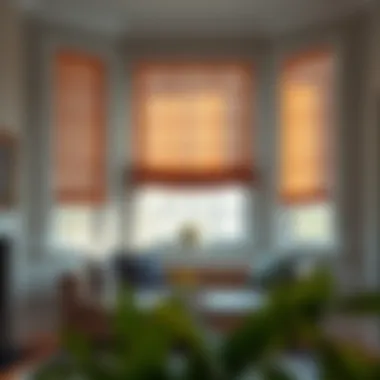
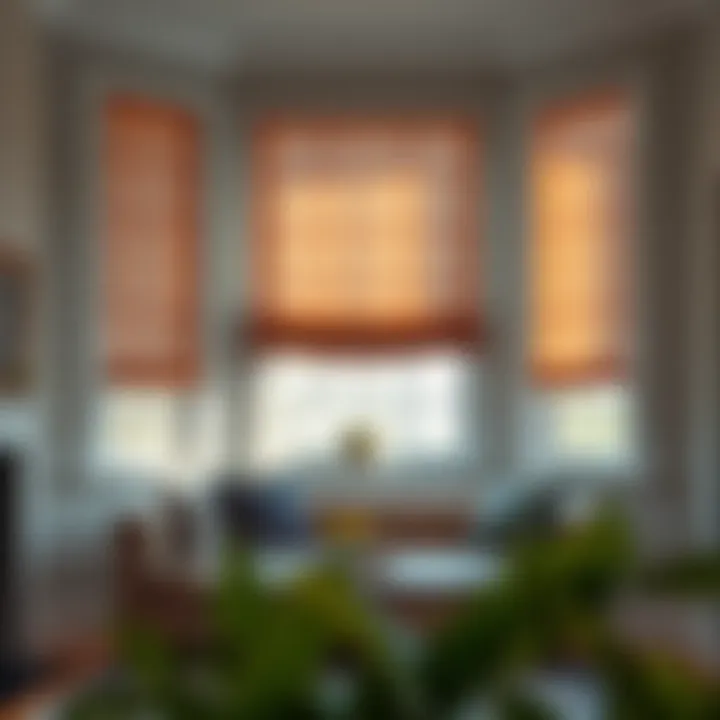
Installation Insights
When it comes to Roman blinds, the installation process is a significant aspect that can greatly influence their overall effectiveness and aesthetic appeal. Understanding how to install these window treatments properly ensures that they function as intended—providing light control and privacy while enhancing the room's decor. This section addresses critical elements of installation, guiding homeowners, designers, and DIY enthusiasts alike in making informed decisions.
Measurement Techniques
Getting the measurements right is half the battle when installing Roman blinds. Using the correct techniques ensures a proper fit, which is crucial for both appearance and function.
- Window Width and Height: Measure the width and height of the window frame from one edge to the other, using a metal tape measure for accuracy. It's advisable to take measurements from three different points—top, middle, and bottom—then average them. This method accounts for any irregularities in the window frame.
- Depth of the Window Frame: Knowing the depth can guide you on which mounting option is appropriate. Measure from the front of the frame to the back where the window meets the wall, allowing you to choose between inside or outside mount options effectively.
- Mounting Surface: Ensure the mounting surface is clean and free from obstructions. It’s a good idea to visualize the blinds in the space to anticipate how they will interact with other elements in the room.
Accurate measurements are pivotal. If they're off, blinds may not function correctly, affecting aesthetics and light control.
Mounting Options
Choosing the right mounting option is essential in determining how Roman blinds fit into your window space. There are two commonly used methods: inside mount and outside mount.
Inside Mount
Inside mount refers to attaching the blinds within the window frame, making them a discreet option.
- Key Characteristic: This approach often gives a clean and seamless appearance, allowing the window moldings to show.
- Benefits: It’s popular because it allows for optimal light control and offers a minimalist solution that doesn’t take up extra space in the room. Additionally, inside-mounted blinds do not protrude into the space, making them ideal for smaller rooms.
- Considerations: One unique feature of the inside mount is that it requires precise measurements to ensure a perfect fit. If the window frame is not completely level, it might result in uneven blinds, potentially affecting their functionality.
Outside Mount
Outside mount, on the other hand, involves attaching the blinds to the wall or the window trim outside the frame, which can create the illusion of larger windows.
- Key Characteristic: This mounting style is particularly useful when dealing with shallow window frames that restrict inside mounting.
- Benefits: It offers better light control when the blinds are fully down, as it can effectively minimize light seepage around the edges. Many people choose this option for aesthetic reasons as well, favoring the dramatic look it can afford to the windows.
- Considerations: The unique feature here is that outside mount can provide additional decorative elements, like a decorative valance. However, it can take up more space visually, and installation may require additional brackets or hardware to secure.
DIY vs. Professional Installation
Deciding whether to take the plunge into a DIY installation versus hiring a professional can be quite the conundrum. Both options come with their own sets of advantages and drawbacks.
- DIY Installation: Tackling the job yourself could be fulfilling if you're handy with tools. It can also save money on labor costs. However, it requires the know-how to avoid potential mishaps. Videos and guides can assist in this process, but there’s always room for error. Incorrect installation can lead to misuse or malfunction of the blinds.
- Professional Installation: On the other hand, hiring a professional might seem like a safer bet. Pros bring experience and tools, often resulting in a quicker and more efficient job. This can be especially useful for complex window shapes or sizes. Yet, it can add up in cost, so budget considerations come into play.
Ultimately, the decision hinges on personal preference, time, and willingness to take risks with DIY projects.
Maintenance and Care
Maintaining Roman blinds is pivotal to ensuring they last and retain their aesthetic appeal over time. Regular care not only keeps the blinds looking fresh but can also enhance their longevity, making them a worthwhile investment for any home. Dust, dirt, and occasional stains can accumulate, potentially detracting from their beauty and function. Therefore, understanding proper cleaning techniques and repair options becomes essential for homeowners and designers alike.
Cleaning Techniques
Vacuuming
Vacuuming serves as the first line of defense against dust and debris that gather on your Roman blinds. This technique is particularly useful due to its gentle approach. By using a soft brush attachment, you can effectively remove loose dirt without damaging the fabric. The key characteristic of vacuuming is its accessibility; it’s a simple task that requires minimal effort.
One unique feature of vacuuming is that it can be done regularly. This prevents the buildup of allergens and dust mites, which can affect air quality in your home. However, one disadvantage is that vacuuming alone often isn’t sufficient for deeper stains, leading to the need for more specialized cleaning methods as well.
Spot Cleaning
Spot cleaning dives deeper into addressing specific stains, targeting areas that vacuuming may miss. This method is beneficial because it allows homeowners to deal with accidents—like spills or marks—as they occur, preventing them from setting. The characteristic of spot cleaning is its versatility; you can use different cleaning solutions depending on the fabric type.
What's unique about spot cleaning is that it can save fabrics from extensive damages associated with larger stain treatments. You can often rejuvenate the appearance of your blinds without the need for a complete overhaul. Yet, there’s a caution to keep in mind: using improper cleaners may harm the material, so it’s essential to test any solution in an inconspicuous area before full application.
Repair and Replacement
Over time and with constant use, Roman blinds may experience wear and tear, leading to necessary repairs or even replacements. Understanding the process of repair is important, as many minor issues, such as frayed cord or misaligned fabric, can be addressed without calling in a professional.
For instance, re-threading cords or adjusting the mechanism can often be a straightforward fix for those with a bit of DIY spirit. However, if the blinds are beyond repair due to severe damage or aging, replacement becomes the logical choice. Homeowners should assess the cost-effectiveness of repair versus replacement, especially if the current blinds are not meeting their needs or aesthetic goals.
In sum, caring for Roman blinds requires a mix of regular cleaning and occasional repairs. This emphasis on maintenance optimizes both their function and beauty in a home setting.

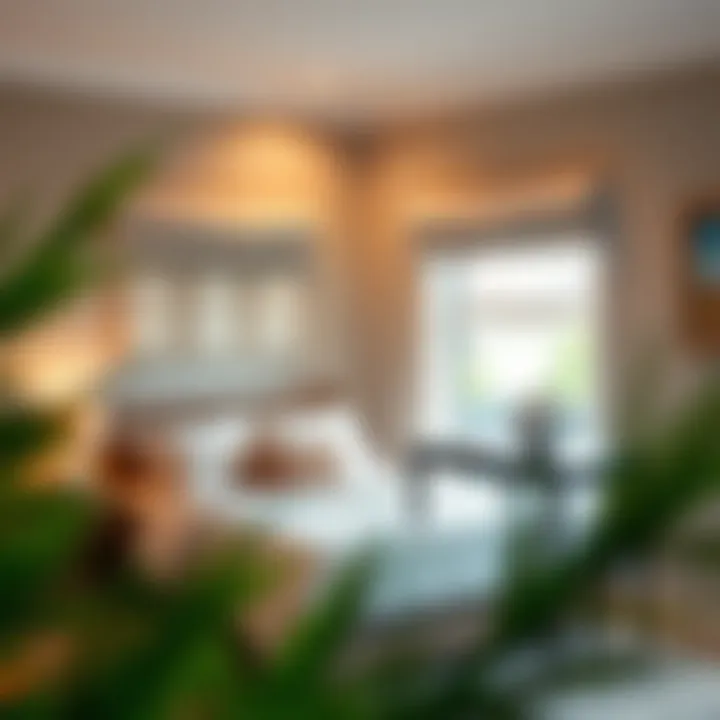
Enhancing Interior Spaces
In today's world, where aesthetics and functionality intertwine, enhancing interior spaces has become a prime consideration for homeowners and designers alike. Roman blinds, with their unique ability to blend elegance and practicality, play a crucial role in achieving this goal. They are more than mere window coverings; they are an integral part of room design, contributing to the overall atmosphere and enhancing the visual appeal of any space.
One of the significant aspects of using roman blinds is their striking versatility in compliments various decor themes. Whether your home leans towards a minimalist, traditional, or modern style, there's a fabric, pattern, and color to match your vision perfectly. By selecting the right roman blinds that resonate with your room's theme, you can achieve a harmonious balance that effortlessly draws the eyes.
Complementing Decor Themes
Roman blinds hold a unique ability to flow with the rest of the decor, allowing for a seamless integration that can make or break the visual appeal of a room. For example:
- In a cozy rustic setting, think about using natural fabrics like linen or cotton in earthy tones.
- If your space embraces a contemporary flair, sleek and bold colors or geometric patterns can elevate the space.
- For a vintage or classical approach, rich fabrics adorned with intricate motifs can add a layer of sophistication.
The right choice in roman blinds can accentuate existing elements, like wooden beams or modern furniture, while also standing out enough to be a focal point. Additionally, incorporating layers can enhance depth—perhaps pairing sheer fabric blinds behind blackout ones—this not only elevates design but also offers functional benefits. When curtains and blinds dance together, they create a delightful duet in any space.
Creating Mood and Atmosphere
The mood within a room can shift dramatically based on lighting and color, and roman blinds serve as a player in this dynamic. They have the potential to control light levels, setting the stage for different atmospheres:
- Soft Morning Light: By choosing light-colored fabrics, you can filter sunlight gently, creating a warm, inviting start to the day.
- Dramatic Evenings: On the other hand, deeper shades can wrap a room in cozy darkness during evenings, adding an air of intimacy for gatherings or relaxed moments.
- Cleansing White Spaces: White or light-colored blinds can amplify sunlight, crafting a fresh, clean environment that feels airy and spacious.
Roman blinds can also be tailored with patterns and textures that evoke emotions. For instance, floral patterns might invoke a springtime freshness, while darker fabrics suggest warmth and coziness during winter months. This ability to shape how a room feels cannot be overstated.
"The choice of window treatments isn't just about addressin' light control but about creatin' a certain vibe in each room."
Investing thought into the blinds you choose means investing in the soul of your interior spaces. It creates an experience for inhabitants and guests alike. Achieving the right mood is sometimes about subtle shifts in how light filters through your home.
With careful selection, roman blinds enable homeowners to forge connections between the indoor and the outdoor. Drawing the eye outward to gardens, landscapes, or city life, these window treatments can facilitate a dynamic relationship between the interior and exterior environments, enriching one’s living experience overall. Offering both utility and style, the right choice of roman blinds can truly transform a space, showcasing the art of interior design at its finest.
Cost Considerations
When embarking on the journey of selecting Roman blinds, navigating through the labyrinth of cost considerations is crucial. This section demystifies the financial aspects involved, bringing to light how expenses can vary significantly based on factors like material, size, and style. Understanding these elements not only aids in budget management but also informs decisions that harmonize aesthetics with functionality.
Budgeting for Roman Blinds
Setting a budget for Roman blinds involves a careful assessment of your needs and preferences. Start by determining the areas where you wish to install these window treatments. Factors influencing the overall cost include:
- Size: Larger windows require more fabric and possibly a more robust installation mechanism, which can hike up prices.
- Material: Fabrics like silk or linen are typically more expensive than synthetic alternatives. If you’re looking for longevity or a specific look, this can be a worthwhile investment.
- Style and Design: Flat styles may be more affordable compared to hobbled designs that have more fabric and layers.
A practical approach is to scout around and gather quotes from several suppliers. Websites like HomeAdvisor can provide estimates that suit your specific needs and region. Additionally, assessing seasonal sales can yield significant savings, especially around holidays.
Cost vs. Quality Analysis
A critical aspect of investing in Roman blinds is weighing cost against quality. While it might be tempting to opt for the lowest price, this can lead to recurring issues, driving up costs in the long term. Here are a few points to ponder:
- Durability: Higher-quality materials not only endure wear and tear better but also retain their visual appeal much longer. Cheaper options may fray or fade, requiring replacement sooner than expected.
- Functionality and Features: Cost-effective blinds might lack advanced features such as moisture resistance or thermal properties that high-end versions provide. If energy efficiency or ease of use is a priority, spending a bit more could yield a significant benefit.
- Aesthetic Appeal: Well-crafted Roman blinds can substantially enhance the overall look of a room. Investing in quality ensures your window treatments complement your décor and don't appear as an afterthought.
In summary, while the initial cost of Roman blinds might seem steep, a thoughtful analysis reveals that prioritizing quality over mere price tags can lead to better long-term satisfaction and less frequent replacements. In the end, the right blinds can be worth their weight in gold.
"Quality is remembered long after the price is forgotten."
Resources like The Home Depot and Lowe’s may provide comprehensive guides to help you balance your desired aesthetic with quality craftsmanship.
Closure and Final Thoughts
As we wrap up our exploration of Roman blinds, it’s essential to underscore their significance within the landscape of window treatments. What shines through is not only their versatility in design but also their capacity to enhance functionality in various home settings. For homeowners, designers, and DIY enthusiasts, understanding the nuances of Roman blinds is vital for making informed decisions tailored to their unique environments.
Recap of Key Points
- Design Flexibility: Roman blinds come in several styles, such as flat and hobbled, allowing for a customization that suits diverse tastes and interiors.
- Material Choices: Ranging from natural fibers like linen to synthetic materials, the right fabric can elevate both the aesthetics and functionality of your blinds, including options for blackout materials that ensure privacy andlight control.
- Functional Benefits: These window treatments excel in managing natural light and enhancing energy efficiency while providing a cozy atmosphere.
- Installation Insights: With straightforward measurement techniques and the choice between DIY or professional installation, getting these blinds up and functioning is manageable for most.
- Maintenance Needs: Regular cleaning and care ensure that Roman blinds continue to look their best over time, enhancing their longevity and visual appeal.
- Cost Considerations: Evaluating quality against budget is key; investing in the right blinds can pay off in durability and satisfaction.
Future Trends in Roman Blinds
Looking ahead, the market for Roman blinds is shifting toward greater sustainability. Eco-friendly materials will likely make a bigger splash, as homeowners increasingly prioritize environmental impact alongside aesthetics. Smart home technology is also making inroads, with automated Roman blinds that can adapt to time of day or sunlight, providing both convenience and energy efficiency. Furthermore, personalization options may expand, enabling clients to not only choose colors and fabrics but also incorporate custom designs that resonate with their individual style.
"The windows of a home are like the eyes of the soul, framed by Roman blinds that reflect its inner character and charm." - Unknown
For more information on Roman blinds and their benefits, check out related resources such as Wikipedia or Britannica.
Engage with communities of enthusiasts on platforms like Reddit to glean insights and tips from those who have successfully integrated Roman blinds into their living spaces.



